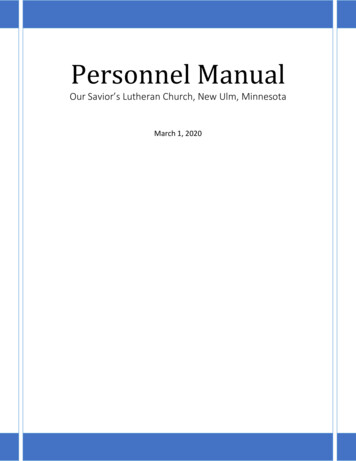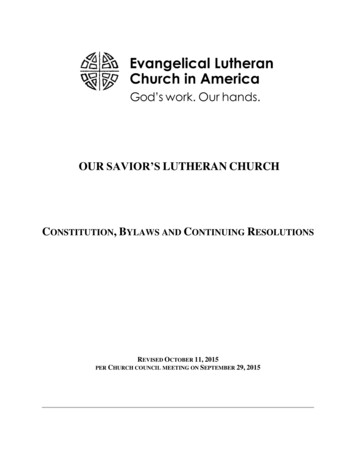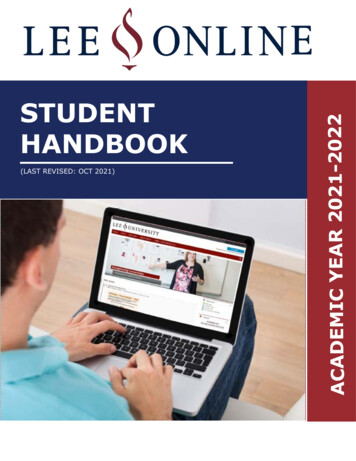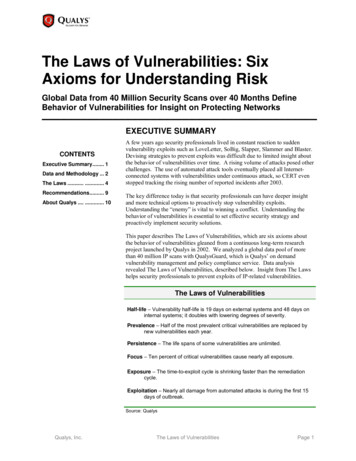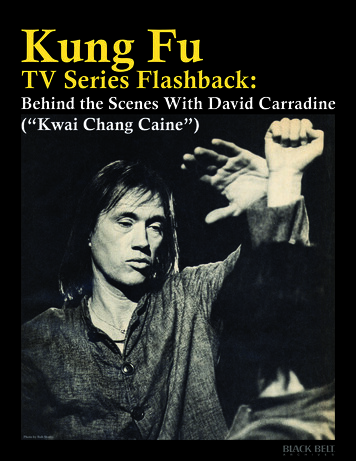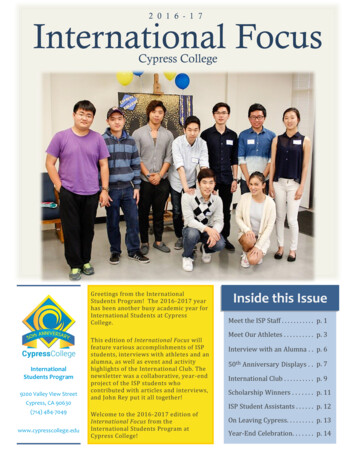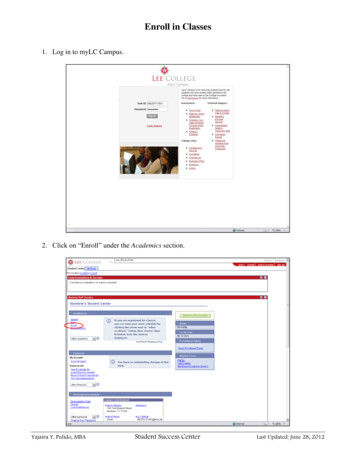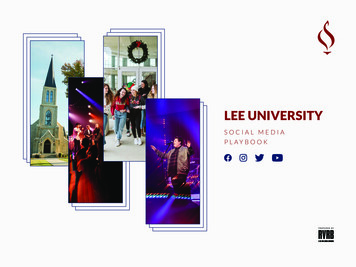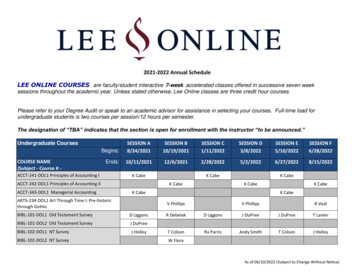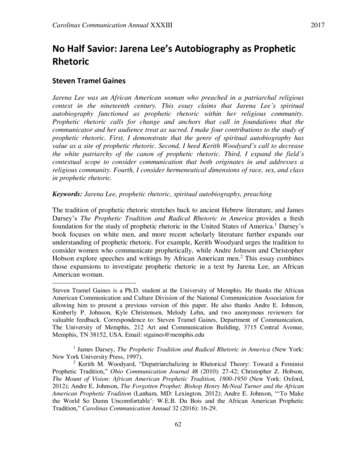
Transcription
Carolinas Communication Annual XXXIII2017No Half Savior: Jarena Lee’s Autobiography as PropheticRhetoricSteven Tramel GainesJarena Lee was an African American woman who preached in a patriarchal religiouscontext in the nineteenth century. This essay claims that Jarena Lee’s spiritualautobiography functioned as prophetic rhetoric within her religious community.Prophetic rhetoric calls for change and anchors that call in foundations that thecommunicator and her audience treat as sacred. I make four contributions to the study ofprophetic rhetoric. First, I demonstrate that the genre of spiritual autobiography hasvalue as a site of prophetic rhetoric. Second, I heed Kerith Woodyard’s call to decreasethe white patriarchy of the canon of prophetic rhetoric. Third, I expand the field’scontextual scope to consider communication that both originates in and addresses areligious community. Fourth, I consider hermeneutical dimensions of race, sex, and classin prophetic rhetoric.Keywords: Jarena Lee, prophetic rhetoric, spiritual autobiography, preachingThe tradition of prophetic rhetoric stretches back to ancient Hebrew literature, and JamesDarsey’s The Prophetic Tradition and Radical Rhetoric in America provides a freshfoundation for the study of prophetic rhetoric in the United States of America.1 Darsey’sbook focuses on white men, and more recent scholarly literature further expands ourunderstanding of prophetic rhetoric. For example, Kerith Woodyard urges the tradition toconsider women who communicate prophetically, while Andre Johnson and ChristopherHobson explore speeches and writings by African American men. 2 This essay combinesthose expansions to investigate prophetic rhetoric in a text by Jarena Lee, an AfricanAmerican woman.Steven Tramel Gaines is a Ph.D. student at the University of Memphis. He thanks the AfricanAmerican Communication and Culture Division of the National Communication Association forallowing him to present a previous version of this paper. He also thanks Andre E. Johnson,Kimberly P. Johnson, Kyle Christensen, Melody Lehn, and two anonymous reviewers forvaluable feedback. Correspondence to: Steven Tramel Gaines, Department of Communication,The University of Memphis, 212 Art and Communication Building, 3715 Central Avenue,Memphis, TN 38152, USA. Email: stgaines@memphis.edu1James Darsey, The Prophetic Tradition and Radical Rhetoric in America (New York:New York University Press, 1997).2Kerith M. Woodyard, “Depatriarchalizing in Rhetorical Theory: Toward a FeministProphetic Tradition,” Ohio Communication Journal 48 (2010): 27-42; Christopher Z. Hobson,The Mount of Vision: African American Prophetic Tradition, 1800-1950 (New York: Oxford,2012); Andre E. Johnson, The Forgotten Prophet: Bishop Henry McNeal Turner and the AfricanAmerican Prophetic Tradition (Lanham, MD: Lexington, 2012); Andre E. Johnson, “‘To Makethe World So Damn Uncomfortable’: W.E.B. Du Bois and the African American PropheticTradition,” Carolinas Communication Annual 32 (2016): 16-29.62
Carolinas Communication Annual XXXIII2017“One of the first African American women known to have preached the gospel inthe thirteen colonies,” Jarena Lee “is regarded as the first woman preacher in the AfricanMethodist Episcopal (AME) Church.”3 She was born on February 11, 1783, in CapeMay, New Jersey. Her parents were poor, and her maiden name is unknown. 4 She workedas a domestic servant for over a decade, in which she learned to read and write.5Following spiritual experiences in which she received her call to preach, she informed herbishop, AME founder Richard Allen, of her calling, which he resisted. Years later, whenAllen finally heard Lee preach, he affirmed her calling but did not ordain her to theministry of preaching. Instead, he limited her to speaking outside the main meetings ofthe religious establishment. Despite this marginalization, Lee’s preaching ministryincluded countless miles, chronic illness, ecstatic results, and danger as she spoke in slavestates. Her journal, in which she argued for her right to preach, first appeared in 1836,was printed again in 1839, and was widely distributed.6This essay claims that Jarena Lee’s spiritual autobiography, especially the sectionin which she explained her right to preach, functioned as prophetic rhetoric within herreligious community. Prophetic rhetoric calls for change and anchors that call infoundations that the communicator and her audience treat as sacred (i.e. deeplytreasured). The “sacred” may or may not be overtly religious, but for Lee it was.7 Shegrounded her narrative and arguments in the Bible, theology, church tradition, andspiritual experiences. That engagement with religious foundations distinguishes theautobiography as a spiritual one.In noting Lee’s autobiography’s prophetic elements, I make four contributions tothe field. First, I demonstrate that the genre of spiritual autobiography has value as a siteof prophetic rhetoric. Second, I heed Woodyard’s call to decrease the white patriarchy ofthe canon of prophetic rhetoric. Third, I expand the field’s contextual scope. Recentscholars of prophetic rhetoric have focused on communication from a religiouscommunity to a larger society, and I consider communication that both originates in andaddresses a religious community. Fourth, I consider hermeneutical dimensions ofprophetic rhetoric at an intersection of race, sex, and class. In making those contributions,I offer three sections in this essay’s body. The first section briefly explains spiritualautobiography, describes Jarena Lee’s spiritual autobiography, and begins to shift intoanalysis. The second introduces a theoretical foundation for the study of prophetic3Martha Simmons and Frank A. Thomas, eds., Preaching with Sacred Fire: AnAnthology of African American Sermons, 1750 to the Present (New York: Norton, 2010), 160;Susan J. Hubert, “Testimony and Prophecy in The Life and Religious Experience of Jarena Lee,”Journal of Religious Thought 54/55:2/1 (1998): 45.4Much of the biographical information is from Simmons and Thomas, Preaching withSacred Fire, 160-163.5Louis Billington, “‘Female Laborers in the Church’: Women Preachers in theNortheastern United States, 1790-1840,” Journal of American Studies 19 (1985): 374.6Hubert, “Testimony and Prophecy,” 45.7Darsey mentions both religious and secular foundations (“Old Testament prophecy andthe received notion of American virtue”) in his The Prophetic Tradition, xi. In Evans’ discussionof W.E.B. Du Bois, “the American ideal that informs democracy” serves as the sacredfoundation. C.f. Joseph N. Evans, “Double-Consciousness: The Du Boisian Hermeneutic,”Homiletic 36:2 (2011): 3.63
Carolinas Communication Annual XXXIIIrhetoric and analyzes Lee’s words through that lens. The third explores the influences ofrace, sex, and class on Lee’s interpretation of ancient texts deemed sacred by hercommunity.Spiritual AutobiographyIn her article “Testimony and Prophecy in The Life and Religious Experience ofJarena Lee,” Susan Hubert uses previous writings by and about Jarena Lee to study thelife of this nineteenth-century preacher.8 Hubert contributes to the field of knowledgeabout Lee and spiritual autobiography, especially in African American experience, in atleast two important ways. First, Hubert calls for historical context to be the primaryinterpretive key of Lee’s spiritual autobiography; literary form is secondary. Second,Hubert notes the communal nature of Lee’s testimony and anchors that communality inthe historic connection of individual and community in African traditions that influenceAfrican American Christianity. The second observation complements a statement byRoderick Hart and Suzanne Daughton: “A message is worth analyzing if it tells a storylarger than itself. . . . Concern for the larger story, therefore, should animate each piece ofrhetorical criticism.”9 To a large extent, with any message, the community is the story,whether that community is hidden, resisted, or embraced.Instead of comparing “Lee’s autobiography to other spiritual autobiographies . . .therefore giving privilege to literary form over cultural context,” Hubert holds that “theAfrican-American church context, rather than other autobiographical texts, is theessential interpretive key to Lee’s autobiography.” Hubert further claims that “The Lifeand Religious Experience of Jarena Lee is not simply a spiritual autobiography; it is bothtestimony and prophecy, and speaks from and to a particular faith community.”10 Thisobservation helpfully contributes to the interpretation of Lee’s narrative; but testifying,prophesying, and speaking “from and to a particular faith community” are commonfunctions of spiritual autobiographies (i.e. autobiographies that use religious languageand tell about religious experiences).11 Hubert, however, writes that “it might be moreappropriate to describe Lee’s book as a testimony rather than a spiritual autobiography.”Importantly, Hubert does not provide a clear distinction between testimony andspiritual autobiography, even as she understands the distinction to have great impact onthe reading of Lee’s story. By treating it as a testimony, Hubert brings to bear on theinterpretation the historical context and collectivistic culture in which Lee preached andwrote. Both are crucial to understanding Lee’s narrative. Her words do not speak in avacuum; they carry power to influence because they are rooted in a prophetic yetpatriarchal religious culture. Her words also exert persuasive force because they areHubert, “Testimony and Prophecy,” 45-52.Roderick P. Hart and Suzanne Daughton, Modern Rhetorical Criticism, 3rd ed. (Boston:Allyn and Bacon, 2005), 32.10Hubert, “Testimony and Prophecy,” 45.11Examples include the following: Leroy Garrett, A Lover’s Quarrel: An Autobiography:My Pilgrimage of Freedom in Churches of Christ (Abilene, TX: Abilene Christian UniversityPress, 2003); Sally Gary, Loves God Likes Girls: A Memoir (Abilene, TX: Leafwood Publishers,2013). My parenthetical definition of spiritual autobiographies uses the term “religious,” but I donot intend to exclude writings by people who might claim to be “spiritual but not religious.”64892017
Carolinas Communication Annual XXXIIIwritten not simply by an individual but by an individual intimately connected as amember of a community of faith. Another observation, which Hubert might have in mindbut does not overtly state, is that knowledge of Lee’s historical and cultural contextsallows readers to understand her appeals to theology, scripture, and pragmatic results asmethods of identification with her audience. Before detailing those appeals, this essayoverviews experiences reported in Lee’s autobiography. 12 That overview sets the stagefor an analysis of her arguments.Lee had spiritual experiences in which she received her call to preach. First, sheendured a shocking silence in which she heard, “Go preach the Gospel!” She objected notby saying that she was unworthy, incapable, or unwilling, but by voicing her fear that“No one will believe me.” Her fear was more about her reception as a speaker than it wasabout the content of her message. She lived in a patriarchal religious culture that had noplace for female preachers. Although women had preached in Christianity since itsbeginning, Lee apparently had not learned about that legacy. 13 The AME Church, areligious community initiated to provide African Americans a worship environmentoutside the restrictions of white assumptions and practices, continued a system of sexualinequality received from their people’s enslavers. Shirley Carlson writes about AfricanAmerican women in the later years of the nineteenth century:The black community’s appreciation for and development of the feminineintellect contrasted sharply with the views of the larger society. In the latter,intelligence was regarded as a masculine quality which would “defeminize”women. The ideal white woman, being married, confined herself almostexclusively to the private domain of the household. She was demur, perhaps evenself-effacing. She often deferred to her husband’s presumably superior judgment,rather than formulating her own views and vocally expressing them, as blackwomen often did. A woman in the larger society might skillfully manipulate herhusband for her own purposes, but she was not supposed to confront or challengehim directly. Black women were often direct, and frequently won communityapproval for this quality, especially when such a characteristic was directedtoward achieving “racial up lift.” Further, even after her marriage, a black womanmight remain in the public domain, possibly in paid employment. The ideal blackwoman's domain, then, was both the private and the public spheres. She was wifeThis paper does not attempt to judge the reality of anyone’s spiritual experiences. Theinformation about Lee’s spiritual experiences comes from her autobiography, The Life andReligious Experience of Jarena Lee, A Coloured Lady, Giving an Account of her Call to Preachthe Gospel: Revised and Corrected from the Original Manuscript Written by Herself(Philadelphia: Printed and published for the author, 1836). This paper uses the reprinting of aportion of the autobiography in Simmons and Thomas, Preaching with Sacred Fire, 163-166.13For historical accounts of women preachers in early Christianity, consult the following:Elaine J. Lawless, “Introduction: The Issue of Blood--Reinstating Women into the Tradition,” inWomen Preachers and Prophets through Two Millennia of Christianity, ed. Beverly MayneKienzle and Pamela J. Walker (Berkeley: University of California Press, 1998), 2; Karen L. King,“Prophetic Power and Women’s Authority: The Case of the Gospel of Mary (Magdalene),” inWomen Preachers and Prophets through Two Millennia of Christianity, ed. Beverly MayneKienzle and Pamela J. Walker (Berkeley: University of California Press, 1998), 21-23.65122017
Carolinas Communication Annual XXXIIIand mother, but she could also assume other roles, such as schoolteacher, socialactivist, businesswoman, among others. And she was intelligent.14That situation may have been the case in the late nineteenth century but apparently wasquite different from Lee’s experience. When she heard the commission to preach, shewas trapped in and formed by a religious system that privileged male voices. Thesilencing of women apparently was not an issue that she was interested to counter prior tothis spiritual experience. Because of that, she assumed the speaker to be Satan. With thatfear, she pursued confirmation of the call and had another spiritual experience, a vision ofa pulpit with a Bible on it. Thereafter, she preached in her sleep loudly enough to wakeup the other inhabitants of the house and even herself.When she informed her bishop, AME founder Richard Allen, of her calling, heresponded that the church’s “Discipline knew nothing at all about . . . women preachers.”She described this experience as a quenching of a fire, albeit a temporary quenching thatwould not permanently extinguish the flame. 15 “Discipline” refers to bylaws, and Allenreferenced the discipline of the larger Methodist denomination. Martha Simmons andFrank Thomas write, “Allen’s serious obedience to the white Discipline was indeedstrange, since he had been breaking ties with the white Methodists since 1787. WasReverend Allen really being faithful to the Discipline, or was he using it to disguise aculture-bound bias against women preachers?”16 According to Simmons and Thomas, thesecond option is likely correct.17 This makes sense in light of the above reportedpatriarchy of the nineteenth-century United States, a patriarchy that was “operative in theAfrican-American church.”18 Deborah Gray White observes that African Americanwomen and men in nineteenth-century slavery on plantations in the South had differentbut complementary roles and experienced mutual respect, but white patriarchy crafted theAfrican American Christianity that Jarena Lee experienced. 19 Years later, when Allenheard Lee preach, he affirmed her calling but did not ordain her to the ministry ofpreaching. Instead, he marginalized her to speaking outside the main meetings of thereligious establishment.After recounting Allen’s initial response, Lee warned, “O how careful ought webe, lest through our bylaws of church government and discipline, we bring into disreputeeven the word of life.”20 She anchored her claim in the words of Jesus: “nothing isimpossible with God” (Luke 1:37). Lee apparently assumed that the biblical rationale forpreaching by men and not by women arose from the theological conviction that men werepermitted to preach because “the Saviour” (Jesus) died for men. Although Lee did notindicate that arguments from Pauline texts in the New Testament were used by herShirley J. Carlson, “Black Ideals of Womanhood in the Late Victorian Era,” TheJournal of Negro History 77 (1992): 62.15In telling this part of her story, Lee uses language from the Hebrew prophet Jeremiah,as noted by Hubert, “Testimony and Prophecy,” 49.16Simmons and Thomas, Preaching with Sacred Fire, 161.17Ibid.18Hubert, “Testimony and Prophecy,” 48.19Deborah Gray White, Ar’n’t I a Woman: Female Slaves in the Plantation South (NewYork: Norton, 1985), 22.20Lee in Simmons and Thomas, Preaching with Sacred Fire, 164.66142017
Carolinas Communication Annual XXXIII2017specific religious community, those arguments were common in the larger context ofChristianity in the nineteenth-century United States.21 She challenged the convictionthrough a series of three consecutive questions. First, “And why should it be thoughtimpossible, heterodox, or improper for a woman to preach, seeing the Saviour died forthe woman as well as the man?” Second, “If the man may preach, because the Saviourdied for him, why not the woman, seeing he died for her also?” Third, “Is he not a wholeSaviour, instead of a half one, as those who hold it wrong for a woman to preach, wouldseem to make it appear?”22After issuing the warning, challenge, and questions, Lee presented a series ofarguments. First, she drew from the biblical account that Mary “first preach[ed] the risenSaviour” (John 20:18).23 That part of the Fourth Gospel portrays Mary Magdalene tellingother disciples of Jesus that she saw him. Although this small group communication doesnot fit the stereotype of preaching as a form of public address, a broader understanding ofpreaching appears later in Lee’s autobiography.Second, she appealed to theology. Specifically, she referenced the doctrine of theresurrection voiced by Mary in John 20 and developed initially by the Apostle Paul. Leedid not cite a specific Pauline text, but she may have thought of First Corinthians 15.Third, Lee dealt with history. As if knowledgeable of forms of preaching in theearly church as well as in the nineteenth century, she mentioned the possibility thatpreaching might have happened differently in the first century than in her own. She stateda view that some in her religious community may have held: “that Mary did not expoundthe Scripture, therefore she did not preach, in the proper sense of the term.” Lee presentedan insightful response: “it may be that the term preach, in those primitive times, did notmean exactly what it is now made to mean; perhaps it was a great deal more simple then,than it is now; if it were not, the unlearned fishermen could not have preached the Gospelat all, as they had no learning.”24 In making her argument, Lee exemplified a commontendency among nineteenth-century female preachers to resist education-basedhierarchical distinctions between Christians. 25Cyrus Cort, “Woman Preaching Viewed in the Light of God’s Word and ChurchHistory,” The Reformed Quarterly Review 29 (1882): 124-126. For a nineteenth-century responseto the use of those biblical texts to argue against preaching by women, see Luther Lee, “Woman’sRight to Preach the Gospel,” pages 92-95 in Five Sermons and a Tract by Luther Lee, edited byDonald W. Dayton (Chicago: Holrad, 1975). The sermons by Cyrus Cort and Luther Lee appearin Barbara J. MacHaffie, Her Story: Women in Christian Tradition, 2nd ed. (Minneapolis:Fortress Press, 2006), 212-215, 225-227. See also Billington, 378. The New Testament texts mostmentioned in discussions of women’s preaching, especially in arguments against women’spreaching, are First Corinthians 14:34-35 and First Timothy 2:11-12.22Lee in Simmons and Thomas, Preaching with Sacred Fire, 164.23Contrary to Preaching with Sacred Fire’s introduction to Lee’s piece, the Mary here isMary Magdalene, also known as Mary of Magdala, not the mother of Jesus.24Lee in Simmons and Thomas, Preaching with Sacred Fire, 164. Research supportsLee’s suspicion about the diversity of preaching forms. Hughes Oliphant Old, The Reading andPreaching of the Scriptures in the Worship of the Christian Church: Volume 1: The BiblicalPeriod (Grand Rapids: Eerdmans, 1998), 9-16; King, “Prophetic Power and Women’sAuthority,” 23.25Billington, “‘Female Laborers in the Church,’” 369-394.2167
Carolinas Communication Annual XXXIIIFourth, Lee presented her call to preach as a gift and anchored it in the biblicalmetaphor of a vineyard.If then, to preach the Gospel, by the gift of heaven, comes by inspiration solely, isGod straitened; must he take the man exclusively? May he not, did he not, andcan he not inspire a female to preach the simple story of the birth, life, death, andresurrection of our Lord, and accompany it too, with power to the sinner’s heart.As for me, I am fully persuaded that the Lord called me to labour according towhat I have received, in his vineyard. 26Given Lee’s already apparent reliance on Pauline theology, her “gift” language likelyarose from First Corinthians 12.Fifth, Lee mentioned her success in preaching. People previously disinterested inreligious matters had responded to her sermons.As for me, I am fully persuaded that the Lord called me to labour according towhat I have received, in his vineyard. If he has not, how could he consistentlybear testimony in favour of my poor labours, in awakening and convertingsinners? . . . I have frequently found families who told me that they had not forseveral years been to a meeting, and yet, while listening to hear what God wouldsay by his poor colored female instrument, have believed with trembling, tearsrolling down their cheeks—the signs of contrition and repentance towards God.27After appealing to the Bible, theology, and history, she mentioned her results as evidenceof her calling.Despite her skepticism regarding her calling to preach, despite marginalization byher religious establishment, and despite her doubt regarding her ability to endure, Leepersevered with hope. She ended her autobiographical account of her calling with amoving reference to God’s love and power to keep her “from falling” (Romans 8:38-39;Jude 1:24). Within her religious community, this God appeal strengthened the previousarguments’ legitimacy.The genius of Lee’s rhetoric is its use of the Bible, theology, history, andpragmatism. Of course, many Christians in the nineteenth-century United States wantedarguments to be anchored in scripture, theology, and tradition. To this blend, Lee addedher success as a preacher. In a culture that valued pragmatic results, her account appealednot only to typical Christian authorities but also to a virtue valued beyond her religiouscommunity. This combination of appeals fueled her prophetic call for change.Spiritual Autobiography as Prophetic RhetoricAndre Johnson defines prophetic rhetoric as “discourse grounded in the sacredand rooted in a community experience that offers a critique of existing communities andtraditions by charging and challenging society to live up to the ideals espoused while2627Lee in Simmons and Thomas, Preaching with Sacred Fire, 165.Ibid.682017
Carolinas Communication Annual XXXIIIoffering celebration and hope for a brighter future.”28 Prophetic rhetoric occurs in a fourpart structure. First is a grounding of “prophetic discourse in what the speaker[s] and theaudience[s] deem as sacred.”29 This grounding occurs in community, a required elementof prophetic rhetoric. “People who adopt prophetic personas,” in other words, “cannot doso as rugged individuals, but must root their ‘prophecy’ within communal traditions,beliefs and expectations.”30 As a member of an African American and religiouscommunity, Jarena Lee grounded her rhetoric in “sacred” foundations—scripture,theology, tradition, and experience. The second part of the structure is "consciousnessraising through a sharing or an announcement of the real situation. . . . Thus, instead ofunveiling the hidden, the prophet reveals the hidden in plain sight” to state “the obviousthat others might be afraid to speak.”31 In this consciousness-raising, a propheticcommunicator wants the audience to reflect on the revealed “situation with the hope ofchanging its ways.”32 Lee may or may not have expected her community to change, butshe boldly addressed her community’s obvious yet overlooked sexism. The third part ofthe structure “is the charge, challenge, critique, judgment, or warning of the audience(s) . . The prophet usually does this by offering reinterpretations of what is sacred andcasting a vision of the world not as it is, but as it could and should be.”33 Leereinterpreted the history and potential of women in Christianity, especially in preachingroles, and empowered her community to envision a future that included proclamation bywomen. Fourth “is the offer of encouragement and hope.”34 Johnson notes two kinds ofhope in this kind of rhetoric. The first is “an eschatological hope . . . a hope that thingswill get better in some afterlife or some other spiritual transformation to some otherworld.” The second is “a ‘pragmatic hope’ . . . a more ‘this-worldly’ and earthly type . . .that grounds itself in the prophet’s belief in the Divine to make right order in this world . . a hope that sees a new day coming.”35 Although Lee did not offer an end-of-time hopeor a realistic expectation that her community would change its sexist ways, she offered anindividual hope, which I will address later.Two areas of confusion threaten to weaken the heuristic value of propheticrhetoric as an analytical tool in rhetorical criticism. First, readers might assume thatprophetic rhetoric predicts future events. Johnson’s definition of prophetic rhetoric,however, involves calling for change and neither requires nor excludes prediction. Recentstudies of prophetic rhetoric arise from ancient Hebrew rhetoric, and propheticJohnson, The Forgotten Prophet, 7. Because I do not present Jarena Lee’s rhetoric asan occurrence of the African American jeremiad, this paper does not incorporate some importantworks in the study of African American prophetic rhetoric. David Howard-Pitney, The AfroAmerican Jeremiad: Appeals for Justice in America (Philadelphia: Temple University Press,1990); Willie J. Harrell, Jr., “A Call to Consciousness and Action: Mapping the AfricanAmerican Jeremiad,” Canadian Review of American Studies 36:2 (2006): 149-180.29Johnson, “‘To Make the World So Damn Uncomfortable,’” 19. This counters Darsey’sclaim that prophetic rhetoric does not appeal to the audience’s foundational values. ConsultDarsey, The Prophetic Tradition, 24.30Johnson, “‘To Make the World So Damn Uncomfortable,’” 19.31Ibid.; Johnson, The Forgotten Prophet, 8.32Ibid.33Johnson, “‘To Make the World So Damn Uncomfortable,’” 19.34Ibid.35Ibid., 19-20. This paragraph de-italicizes some words that Johnson italicizes.69282017
Carolinas Communication Annual XXXIIIcommunicators in that context sometimes predicted and sometimes did not. When theypredicted, they did so to call for change. The change was the focus. Second, readersmight assume that the phrase identifies the words only of someone in a specificministerial position, as if only “prophets” speak prophetically. Christopher Hobson,however, writes that prophetic rhetoric is more than an office but is “a kind of speech orwriting that occurred to its practitioners as they turned to questions that arose incommunity life.”36 Johnson similarly focuses on prophetic personas instead ofdeciphering who is or is not a prophet. This essay likewise does not attempt to determinewhether Jarena Lee was a prophet. Instead, using the language of Johnson’s definition toguide analysis, the following five observations reveal that Lee communicated in aprophetic manner.First, Lee’s story is “discourse grounded in the sacred.”37 Her story is more thanjust an autobiography; it is a testimony that speaks to people in power who have silencedher. Furthermore, it is rooted in sources esteemed by her religious community assacred—scripture, theology, tradition, and spiritual experience.Second, her story is “rooted in a community experience.”38 As stated above,Hubert asserts that Lee’s story should not be read in isolation without consideration ofher religious community. That is true of any story and is especially pertinent to one thatspecifically mentions parts of its community, as Lee’s did. It referenced people, texts,traditions, and experiences of her religious community. Also, her religious communitywas part of a larger African American community, although Lee did not highlight racialissues but instead argued for the right to preach, as a woman, within her AME context.Furthermore, her story is rooted in the “community experience” of women, who werelargely marginalized and silenced in the nineteenth-century United States. There is noevidence, however, that she had any intention to contribute to the developing movementtoward women’s rights. Her preaching did not focus on that topic but rather stressed abasic message of Christian proselytism. Her testifying autobiography, on the other hand,directly attacked patriarchal perspectives that limited women’s participation in ministry.Although the extent
No Half Savior: Jarena Lee's Autobiography as Prophetic Rhetoric Steven Tramel Gaines Jarena Lee was an African American woman who preached in a patriarchal religious context in the nineteenth century. This essay claims that Jarena Lee's spiritual autobiography functioned as prophetic rhetoric within her religious community.
